Gabriola islanders have been known to complain (in private, of course) about the number of summer visitors they get. The complaints relate, mostly, to meal prep and washing of linens and such. But visitors are one of the perks of living on a beautiful gulf island in the Salish Sea that I’m grateful for. Without them, I might never get to the beach! Last summer, for example, we spent a delightful afternoon at Twin Beaches, the grandkids’ favourite Gabriola beach. They love digging in the sand and turning driftwood logs into rafts. And I love watching them – and the birds I never see in my back yard, like the female Belted Kingfisher (Megaceryle alcyon) that sat on the end of a tree branch on the far shore all afternoon.
We heard its loud rattling call (reminiscent of a heavy teacup shaking on a saucer) for a while before we saw it. Then, in the distance, a white spot on a tree (its belly) gave it away. (I was glad I’d remembered to bring my binoculars.) You can hear ten different calls of the Belted Kingfisher at: www.allaboutbirds.org/guide/Belted_Kingfisher/sounds.
The short, stocky Belted Kingfisher is found across North America, Central America and the West Indies – and as far south as South America at some times of the year. (And on the 1986 series Canadian $5 bill.) But it breeds only in North America, and is a year-round resident on the west coast of Canada. This kingfisher is unmistakable with its large head, shaggy crest, white collar, long heavy bill, and small weak feet. Both sexes have a blue-grey back and breast band. If you get up real close you can also see the distinctive white dot in front of each eye. The bird we saw, a female, is more colourful than the male because of her rufous belly-stripe. (The male’s belly is pure white.) The kingfisher is one of the few bird species that exhibit reverse sexual dimorphism, in which the female is more brightly-coloured than the male.
As its name suggests, the biggest part of the kingfisher’s diet is fish. But it also eats aquatic invertebrates, insects, reptiles, and small crustaceans. Since it has to see the tasty meals swimming unawares just beneath the surface, the kingfisher likes water habitats with little underwater vegetation. When hunting it perches on a ‘watchpoint’, such as the end of an exposed branch or a sailboat mast, and scans the water. When it sees a likely meal, it flies above the area, hovers for a few moments above the water, then dives vertically into the water, spreading its wings to break its fall. Then it plunges headfirst into the sea in an aerial dive, grabbing its prey from just below the surface. (Unlike many sea birds, the Belted Kingfisher doesn’t submerge itself completely when hunting. It will do so, however, to escape falcons and hawks.) The kingfisher grabs the fish in its beak with a pincer-like movement, and flies back to its perch.
There, it often knocks the fish unconscious on a branch before swallowing it whole, head first. You can watch a Belted kingfisher fishing here: http://www.youtube.com/watch?v=UUwgjKCcnxI (Thanks to the ‘Neighborhood Naturalist for this video.)
During the breeding season, the Belted Kingfisher is found near streams, rivers, lakes and estuaries with somewhat vertical earth banks. The male selects a potential nest site, usually within a few feet of the top of a bank, and holds a kind of avian open house to which females of the species are invited.
This leads to noisy courtship displays followed by, eventually, the male and one female getting serious. The male perches alongside the female and both birds perform a specific kingfisher dance along the length of a perch. Finally the male offers the female the gift of a fish. I assume that her acceptance of the fish is her way of saying “I do.” For this season, at least. Then, using their two fused toes as shovels, the pair build a tunnel in the wall of the bank, where they construct a nest that slopes slightly upward so water cannot easily enter. Once their home is prepared, the female lays 5-8 eggs, and both male and female incubate them. When the babies hatch, both parents regurgitate fish to feed their young. Belted Kingfishers fiercely defend their nesting site, chasing away any intruders aggressively.
If you visit Gabriola in the spring you’ll probably have the opportunity to watch these beauties along the sandstone banks by the ferry dock. It’s certainly worth the trip!



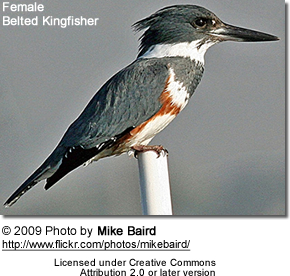
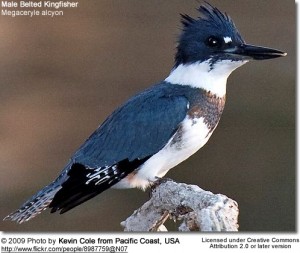
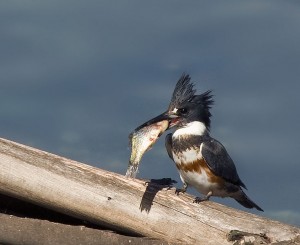
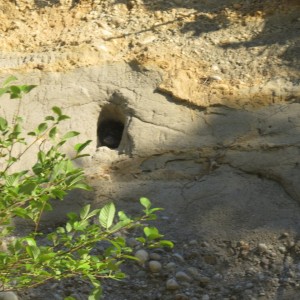
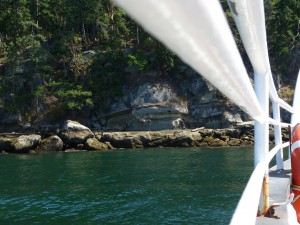
Glad you enjoyed the post David. Thanks!
Great post, great photos! For some inexplicable reason I had trouble finding one of these beautiful birds this year but eventually spotted the tell tale streak of blue along Fish Creek here in Calgary.
Thanks Pierre!
It is also one of my favourite birds. Great photos and blog, BTW!
Thanks Dan. Glad you enjoyed the post.
Great post. Often a tough bird to get close looks at